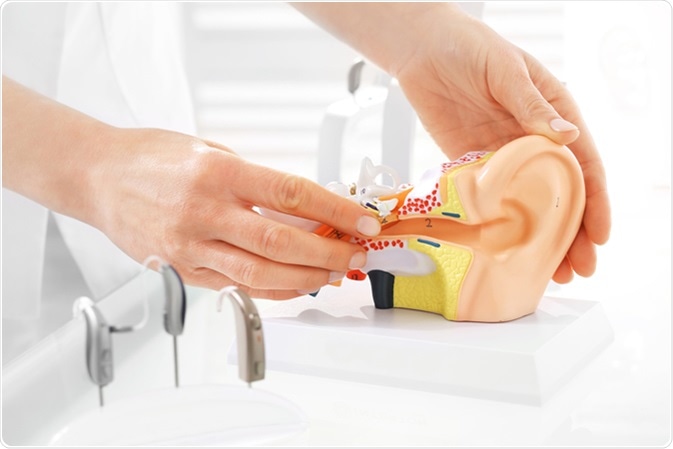The loss of hearing is often the first sign people pay heed to when it comes to audiology. The person tends to turn on the volume of the television louder than other family members, or tends to find it difficult to hear someone speaking right next to them.
There may even be a ringing in the ears when there is no sound actually present. This condition is called tinnitus and is fairly common. It is symptoms like these that show up on the person’s radar alerting them or their family members to the fact that not all may be well with their hearing.

Diagnostic Tests in Audiology
A number of diagnostic tests are currently available for the field of audiology. Based on the symptoms of the person, the audiologist will recommend specific tests. Here are some common tests which may be requested.
Pure tone audiometry
The test requires wearing a pair of headphones and pressing a button every time a sound is heard. The purpose of this twenty minute test is to check the different thresholds of hearing for the person at a variety of frequencies.
Tympanometry
This is a simple five minute test that checks the ear drum and the middle ear for faults. There is a humming sound played which the person listens to. A sensation of mild pressure may also be felt in the ear during this hearing test.
Speech audiometry
This is a half hour hearing test designed to check if the person is able to recognise speech. A set of words will be heard by the patient and then they must repeat them back to the audiologist. The word lists are also presented at different intensities.
Auditory reflex testing
This is a test that really doesn’t require any external inputs from the person. For about twenty minutes they sit and listen to beeping sounds. The computer administrating the test automatically checks for the nerve signals that go to and from the brain.
Oto-acoustic emissions
This is a test for the outer hair cell function of the cochlea or inner ear. The person needs to sit quietly and listen to sounds like hums and clicks. The test takes about twenty minutes to administer as results are recorded automatically.
Auditory brainstem response
This audiology test helps to check if the hearing nerve is functioning normally. The person will have to lie down and relax for about twenty minutes. While lying down still the person will have to listen to click sounds. The entire test takes about half an hour to perform.
Auditory processing test
While speech is one aspect of hearing sounds, we should also be able to catch and hear non speech sounds made around us. This is what the auditory processing test checks for. For about an hour the person is made to listen to different patterns and durations of sounds. They must then say what they heard to the audiologist.
Cortical evoked response audiometry
This is a longer test which lasts about an hour and half. Fortunately, the person is supposed to listen to beeps while comfortably sitting in a chair and reading a book, therefore it isn’t very demanding. The test checks for the functioning of the cortex of the brain when the person hears the beeps.
Caloric test
This is a physically uncomfortable test as the person is stimulated to feel dizzy. The person will be lying down during the test with a pair of eye recording glasses on. Warm and cool water are sent into the ear canals with breaks in between. The test lasts about an hour and checks the balance function dictated by the vestibular system.
ENG chair test
This is an hour long test which involves following small lights with the eyes while seated in the dark. The chair itself will rotate in a small circle and there is likely to be a black and white striped curtain around the test area. The purpose of this balance test is to check the ability of the eyes to follow targets and move in response to the chair’s rotation.
Posturography
This twenty minute long test checks the way a person keeps balance in a multitude of conditions. The person will be made to stand as still as possible on a platform; the platform will move or tilt and the person must correct their posture accordingly. A harness will be used to keep them safe from falling off the platform.
Electrococheleography
This half hour long test checks the activity of the cochlea or inner ear. It is a balance test requiring the person to listen to a loud sound while lying down. A needle containing the sensor is placed through the eardrum by the doctor to record the results.
References
- https://www.uclh.nhs.uk/OurServices/ServiceA-Z/ENTS/ADA/Pages/dtada.aspx
- https://www.audiologist.org/resources/patients/faq
- https://www.osla.on.ca/en/Audiologist?mid=ctl00_LeftMenu_ctl00_TheMenu-menuItem000
Further Reading
- All Audiology Content
- What is Audiology?
- What Does an Audiologist Do?
- Audiology Research
- What is the Role of an Audiologist?
Last Updated: Feb 26, 2019

Written by
Cashmere Lashkari
Cashmere graduated from Nowrosjee Wadia College, Pune with distinction in English Honours with Psychology. She went on to gain two post graduations in Public Relations and Human Resource Training and Development. She has worked as a content writer for nearly two decades. Occasionally she conducts workshops for students and adults on persona enhancement, stress management, and law of attraction.
Source: Read Full Article
